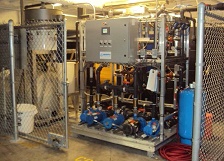 WASHINGTON, D.C.—Those looking for assurance that a laundry wastewater recycling system does indeed reduce utility costs can find proof in study results recently released by the U.S. Department of Energy (D.O.E.) Building Technologies Office. The D.O.E., with the assistance of outside consultants, conducted a demonstration project to evaluate laundry wastewater recycling technology in the hospitality sector. The D.O.E. report, entitled, “Demonstration of Advanced Technologies for Multi-Load Washers in Hospitality and Healthcare—Wastewater Recycling Technology,” documents the demonstration of a wastewater recycling system installed at the Grand Hyatt Seattle.
WASHINGTON, D.C.—Those looking for assurance that a laundry wastewater recycling system does indeed reduce utility costs can find proof in study results recently released by the U.S. Department of Energy (D.O.E.) Building Technologies Office. The D.O.E., with the assistance of outside consultants, conducted a demonstration project to evaluate laundry wastewater recycling technology in the hospitality sector. The D.O.E. report, entitled, “Demonstration of Advanced Technologies for Multi-Load Washers in Hospitality and Healthcare—Wastewater Recycling Technology,” documents the demonstration of a wastewater recycling system installed at the Grand Hyatt Seattle.
The Grand Hyatt, a four diamond hotel located in downtown Seattle, has 425 guestrooms, three restaurants, and over 25,000 square feet of conference space. In addition to the Grand Hyatt, laundry from Hyatt’s nearby Olive 8 property is also processed in the Grand Hyatt Seattle laundry facility. The Olive 8 is a full-service hotel and has 346 guestrooms and 12,000 square feet of function space.
The Grand Hyatt Seattle laundry facility makes use of five hard-mount Alliance Laundry/Speed Queen commercial washers. This equipment serves the laundry needs of all guestrooms (towels, sheets, etc.) and conference rooms (table linens, etc.) from the two Hyatt hotels, processing about 280,000 pounds of laundry monthly.
Utilities used by the Grand Hyatt Seattle laundry facility include electricity (pumps, motors and controls), purchased steam (water heating) and water/wastewater.
System Installed in 2013
The Grand Hyatt’s water recycle system was installed in 2013 and is a skid-mounted, fully contained system constructed, installed and serviced by AquaRecycle of Marietta, Ga. This system can be installed as new construction or as add-on retrofit technology. In the case of the Grand Hyatt Seattle, this was a retrofit application.
The recycle system functions by first pumping the wastewater to a holding tank from where it is pumped to a lint removal vibration system for removal of all large solids in the process water. Next, a pump sends the water through pressure filters to remove suspended solids, oil/grease, soaps and other organics. This water is then sent to the water recycle tank. Prior to being re-injected into the wash system, ultra-violet and ozone disinfectant systems are used to kill all bacteria before the water goes back into the washing process.
The system components that consume energy include the numerous pumps, lint removal, and disinfecting systems. Similar to other recycle systems, the fully automated filtration systems allow for simple deployment and monitoring of the individual peripherals.
AquaRecycle supplied the wastewater recycle system at an approximate installed cost of $100,000. The recycling system was already in place prior to the study.
The results of the evaluation are based on data collected from November 2013 to February 2014. During that time the wastewater recycle system saved an average of 365 thousand gallons/month of combined water and sewer and 1,119 therms/month in hot water heating energy, while adding an electrical load of 1,922 kWh/month. Hot water heating in this case came from steam which is provided by Seattle Steam, which generates the steam using natural gas as the fuel. In addition to the savings provided, laundry staff and facility engineering noted the technology integration went smoothly and overall customer satisfaction of the linens remained high.
Payback of Less Than One Year
The Grand Hyatt Seattle is characterized as having relatively high utility rates—especially water and wastewater rates. The wastewater recycle system projects to save 5,175 kgal of water/sewer and 15,850 therms of hot water heating energy annually while adding an electrical load of 27,220 kWh to operate the system. The result is significant net utility cost savings and a simple payback period of less than one year for the Grand Hyatt Seattle. The evaluation shows this technology could be financially attractive for hotels with similar laundry volume and similar utility characteristics. It also shows the system can be integrated at a high-end hospitality facility without negatively impacting the operation of the central laundry or the quality of the linens being laundered.
According to the D.O.E. report, barriers remaining to wide adoption of laundry water recycling technology include lack of familiarity with the technology, resistance to change, capital costs, space limitations, low utility costs, resistance from detergent chemical suppliers, disinfection and health and safety concerns, and the fact that there is one more stakeholder in an already crowded room.
Suggested recommendations for advancing the technology include a targeted outreach campaign, financial feasibility calculator, rebates from local utilities, and greater collaboration between wastewater recycling system manufacturers and washer manufacturers.
Click here to access the entire D.O.E. report.
Glenn Hasek can be reached at editor@greenlodgingnews.com.






